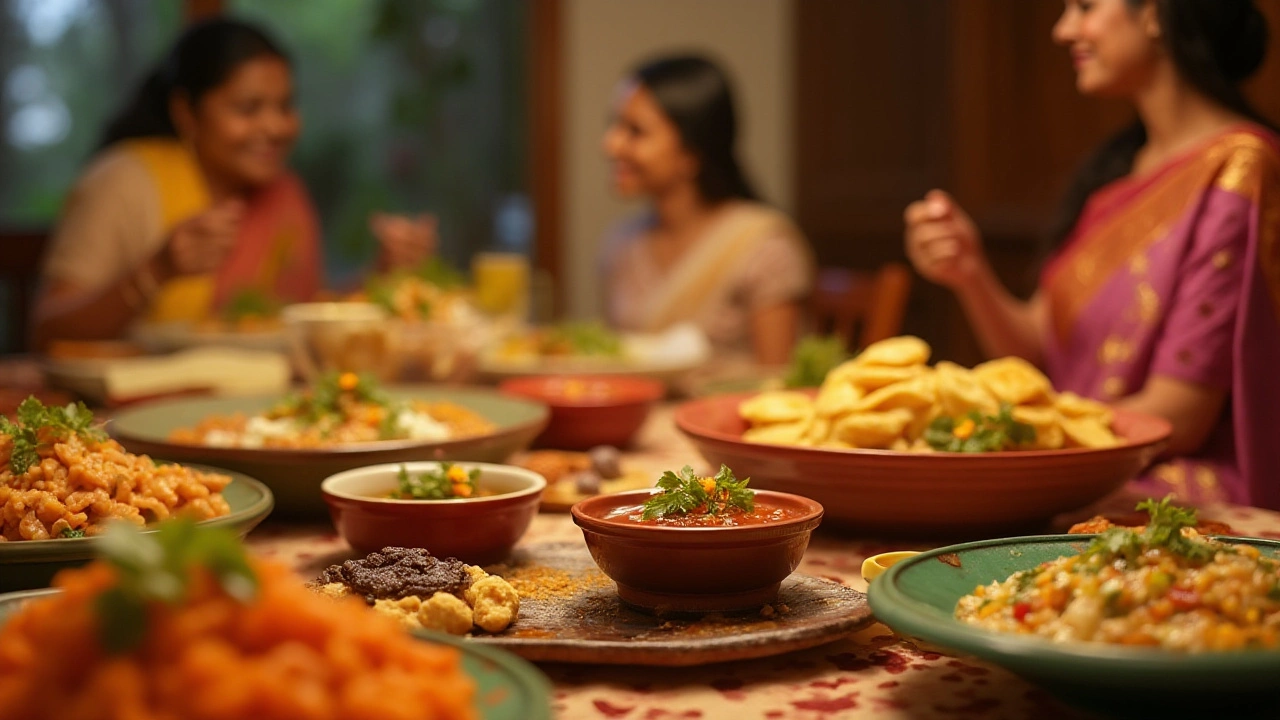Chutney, with its myriad flavors ranging from sweet and tangy to spicy and savory, is no stranger to the culinary world. It has long been a staple in South Asian cuisine, celebrated for its ability to elevate the simplest of dishes. Often served as an accompaniment, each spoonful of chutney is a whirl of excitement for the taste buds. However, while enjoying its tantalizing tastes, one might overlook the less glamorous aspects that come along with it.
As delightful as it may be, chutney's ingredient list often sneaks in significant amounts of sugar and salt, which can be misleading for the health-conscious eater. Moreover, the mix of fruits, vegetables, and spices might not sit well with everyone, potentially leading to allergic reactions or dietary discomfort. There's also the matter of shelf life; improper storage can quickly turn your beloved chutney into a health hazard rather than a healthy supplement.
But fear not, for these disadvantages don't necessitate saying goodbye to your favorite chutney jars. Instead, they encourage a more mindful approach, prompting us to experiment with healthier versions or simply adjust our consumption habits. As we delve into the nuances of chutney's disadvantages, we'll also uncover tips for enjoying it in a way that's both delicious and beneficial.
- Nutritional Considerations
- Potential Health Impacts
- Preservation and Storage
- Tips for Healthier Chutney Consumption
Nutritional Considerations
When indulging in a serving of chutney, it's easy to get lost in its robust flavors, but beneath that enticing zest lies a nutritional profile that deserves a closer look. Chutney's core ingredients often include fruits, vegetables, and spices, each contributing their own nutrients to the mix. However, it’s not just about what’s added in; it’s also important to consider the quantities and how they interact with our diets. One of the primary nutritional drawbacks of chutney is its sugar content. Particularly in fruit-based varieties, sugar not only enhances the sweetness but also acts as a preservative, which can quickly add up to more than a daily recommended intake if consumed unchecked.
Sodium is another element that tends to sneak in with chutneys, especially those that are more savory or pickled. High sodium intake has been linked to increased blood pressure and heart-related issues, posing a risk for those susceptible to such conditions. It's easy to overlook the salt in chutney when it's just a spoonful here and there, but cumulatively, it can tip the scales toward excessive sodium consumption. Chutney recipes with pickled ingredients often contain vinegar or lemon juice, which contribute to the tangy taste yet also increase the acidity. While not detrimental for most, those with sensitive stomachs or acid reflux might find this a problem, making it essential to be aware of personal dietary needs.
Another layer to consider is that of hidden allergens. Many chutneys make use of nuts, seeds, or spices that can cause reactions ranging from mild intolerance to severe allergic responses. Peanut chutney, for instance, can be delicious for some, while life-threatening for others. Awareness and label reading become critical here, especially when purchasing pre-made products.
In the words of renowned nutritionist Dr. Harleen Kaur, "While chutney provides a delightful burst of flavor and even some nutritional benefits, understanding its components allows us to appreciate it responsibly without compromising our health goals."
Given these factors, balancing pleasure and health is key. Moderation is vital, and one might consider homemade alternatives as a means to regulate ingredients and serve sizes more effectively. By doing so, the love for chutney recipes doesn’t have to conflict with maintaining a healthy diet. Nutritious doesn't have to mean bland, and with a few mindful adjustments, chutney can remain an exciting supplement to meals rather than a dietary dilemma.

Potential Health Impacts
Chutney, with its rich and flavorful heritage, can be as delightful as it is deceiving when it comes to potential health impacts. Many traditional recipes prioritize taste, sometimes at the expense of nutritional balance. A prominent concern is the high sugar content in certain types of chutneys, particularly those made with fruits like mango or tamarind. These not only spike blood sugar levels but can also contribute to the daily sugar intake, which over time, can affect one's health adversely by increasing the risks of diabetes and weight gain.
Sodium levels present another challenge for chutney lovers. Many chutneys rely on substantial salt content for both flavor and preservation. Regular consumption of high-sodium foods can lead to hypertension, a condition that affects millions globally and contributes significantly to cardiovascular complications. It's important to be mindful of these levels, especially when pairing chutney with already salty dishes, creating a cumulative effect that can be damaging to one's health.
According to the World Health Organization, adults should consume less than 5 grams of salt (about one teaspoon) per day to reduce the risk of hypertension and related heart diseases.
Another notable health consideration is the potential for allergies and digestive issues. The ingredients used in chutney, such as nuts, certain spices, or even fruits, can trigger allergic reactions in people with specific sensitivities or intolerances. Additionally, spicy chutneys might not agree well with those who suffer from stomach ailments or conditions such as acid reflux, exacerbating symptoms and causing discomfort.
The preservation methods used in store-bought chutneys include additives and preservatives, which, while extending shelf life, might raise health concerns regarding chemical intake. Homemade chutneys also face storage challenges, and the potential for spoilage could pose food safety risks if not handled properly. Embracing a cautious approach and possibly considering low-sugar, reduced-salt alternatives can make enjoying chutney a much healthier experience.
Being informed about these potential impacts helps in aligning our dietary choices with our health goals. Emphasizing moderation and being aware of the ingredients can aid in maintaining a balanced intake. As with many beloved foods, the key lies not in complete avoidance but in discerning consumption that celebrates the flavor and yet guards one's well-being.

Preservation and Storage
When it comes to chutney recipes, preservation and storage take center stage. This beloved condiment, rich in flavor and zest, demands careful attention to ensure it remains safe and enjoyable. High moisture content in chutneys can make them prone to spoilage, primarily due to microbial growth. It's essential to recognize that factors like temperature control and airtight storage play crucial roles in extending the life of this delight. Traditionally, chutneys have been preserved using methods like canning and refrigeration, each offering varied timelines for consumption. Without proper storage, chutneys can quickly turn unpalatable, posing potential health risks.
Chutney disadvantages in terms of storage often emerge from improper handling. Consider the role sugar and vinegar play as natural preservatives. While they extend shelf life, these ingredients also mean chutney can have unintended high sodium and sugar loads—something health-conscious individuals often find challenging. Non-acidic chutneys, like those made primarily from vegetables, may risk spoilage quicker due to lower acidity levels, making them more susceptible to bacteria. Balancing taste and preservation can be tricky, but ensuring cleanliness during preparation and storage can make a significant difference.
Refrigeration and Beyond
Refrigeration undoubtedly extends the life of most chutneys by reducing the chances of microbial growth. However, not all chutneys thrive the same way under cold conditions. For example, chutneys made with coconut may not fare as well due to the ingredient's tendency to spoil faster, even in cooler temperatures. It's equally important to use clean utensils when serving chutney to prevent introducing bacteria that could shorten its lifespan despite refrigeration. Home-canned chutneys stored in sterile environments can last up to a year without refrigeration, offering an alternative for those looking to avoid frequent fridge clutter.
Interestingly, according to culinary expert Madhur Jaffrey, "A single bottle of chutney in an airtight container, stored well, can be your companion for months, even years, weaving stories of taste across seasons." This highlights not only the practical benefits of efficient storage but also the emotional attachment and culinary narrative that chutney can bring to a kitchen.
Practical Tips for Longer Shelf Life
For those searching for longevity in their chutneys, consider utilizing airtight glass jars, which prevent contamination and preserve flavor. Additionally, labeling containers with preparation dates can help manage consumption before spoilage occurs. A practice often overlooked is sterilization, which involves washing jars in hot, soapy water and then heating them in an oven or boiling water bath before filling. This precautionary step can dramatically extend shelf life. It’s also wise to periodically check for signs of spoilage, such as off-smells, mold, or changes in texture, to prevent adverse health impacts. In embracing these simple but effective measures, anyone can ensure their chutney collection remains a safe and delightful addition to their meals.

Tips for Healthier Chutney Consumption
Anyone who's ever added a dollop of chutney to their meal knows the magic it brings, but like many good things, moderation and technique are key. When integrating chutney into your diet, one of the simplest yet most effective changes you can make is opting for fresh, local ingredients. This not only supports sustainable agriculture but also ensures that your chutney is free from unnecessary preservatives and artificial additives often found in commercial options. Start by prioritizing organic fruits and vegetables, as these are less likely to contain harmful pesticides. Embark on a culinary adventure by visiting local markets to discover fresh, seasonal items that will bring new flavors and health benefits to your chutney creations.
Another essential tip involves being mindful of how much sugar is used. Traditional chutney recipes can sometimes require a hefty amount of sugar to balance the flavors, but reducing this can significantly improve the healthiness of the final product. Consider natural sweeteners like honey or agave syrup as alternatives. For those who love spice, be cautious about the type and quantity used; sometimes, less is more when preserving health. Chutney recipes can turn from nutritious to harmful if loaded with too much salt or spice, both of which can affect blood pressure and digestion. It's always wise to taste as you go and adjust the spices accordingly.
Let’s explore cooking methods as well. Instead of relying solely on traditional stove-top cooking, which can sometimes diminish the nutrients in the ingredients, consider other preparation methods such as steaming fruits before blending them into chutney. This helps retain more of the natural vitamins while achieving the desired consistency. Balancing flavors can also benefit from adding more fiber-rich items like grated carrots or leafy greens, providing texture and nutrients. These tweaks can transform your chutney into a hearty delight that complements your meals while providing essential nutrients.
"Incorporating more plant-based components into your condiments boosts the dietary fiber intake," advises Dr. Jane Simmons, a nutrition expert with over two decades of experience in holistic diets.
Another crucial aspect of healthier chutney consumption is practicing portion control. Given its strong flavors, a small serving can be more than enough to satisfy your taste buds without overindulging. Make it a habit to serve chutney in smaller dishes rather than directly from the jar, which can help in monitoring intake. This simple change can make a substantial difference in controlling calorie consumption, especially if you're enjoying a variety regularly with each meal. Additionally, encourage your family and friends to explore these healthy practices by sharing fantastic, nutritious recipes that highlight the deliciousness of thoughtfully crafted chutney.
Lastly, remember the magic of improvisation. The joy of making chutney lies in its versatile nature. You can experiment by adding different herbs, spices, or even nuts to create a unique version that suits your palate while keeping health factors in check. For those who enjoy a kick, consider infusing a little ginger or turmeric, known for their anti-inflammatory properties. The possibilities are endless, and each adventure can lead to a healthier, more delightful chutney experience. With these tips, you can relish the zest of chutney while embracing a mindful approach to consumption.
